 |
My abiding problem with opera is the trite stories, clichéd characters and simplistic themes that seem wholly unworthy of their magnificent setting.  As Harold Schonberg aptly put it, most librettos are "literary trash set to unforgettable music." But when the source is Shakespeare, the qualitative gap between text and music abates. As Harold Schonberg aptly put it, most librettos are "literary trash set to unforgettable music." But when the source is Shakespeare, the qualitative gap between text and music abates.
Giuseppe Verdi (1813–1901) was a life-long enthusiast of Shakespeare, albeit in Italian translation, as he had insufficient facility in English to understand the original texts. Prior to his full fame, in 1846 he had scored a mild success with a largely conventional Macbeth (heard nowadays in an 1865 revision), and in 1843, 1846, 1850 and 1853 he had struggled unsuccessfully with various attempts to realize King Lear. Late in life he finally struck gold with Otello.
The libretto for Otello was by Arrigo Boito (1842–1918). He, too, understood little English and thus could not appreciate (nor seek to emulate) the rhythm and sound of Shakespeare's words that have enthralled fans for centuries. Yet, despite the necessary filters, his text has been hailed as Shakespearean, if not literally of Shakespeare.
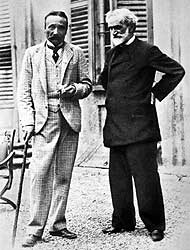
Boito and Verdi in 1892 |
He had prepared the libretto for Amleto [Hamlet], an 1865 opera by Franco Faccio, who would emerge as Italy's finest conductor and would lead the world premiere of Otello. While Verdi was an uneducated peasant (and proud of it, continuing to farm throughout his life), and strictly a composer, Boito was of royal birth, cosmopolitan and a respected critic, historian, poet – and composer; his 1868 Mefistofele, based on the Faust legend, boasts an opulent prologue that ranks among the most thrilling scenes in all of opera. Boito and Verdi had collaborated briefly in 1862 on The Hymn of the Nations, a trite but functional cantata for tenor and chorus created for the London Universal Exhibition that combined the English, French and Italian national anthems (to which Toscanini added the "Star Spangled Banner" and "Internationale" for a revival during World War II). Then they had drifted apart.
Despite their divergent ages, backgrounds and careers, Verdi and Boito had something far more potent in common – their love of Shakespeare. According to many accounts, their collaboration on Otello was prompted by an 1879 dinner among Faccio, Verdi and his publisher Ricordi. Wealthy and greatly revered, Verdi had all but retired from the theatre. It had been eight years since his last opera, Aida, and in the interim he had produced only a single work – a Requiem.
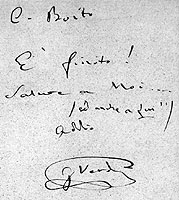
"D[ear] Boito / It is finished! /
Salute to Us ... / (and also to Him!!) /
Farewell / G Verdi" |
Verdi seemed quite content to pursue philanthropic projects and enjoy his vast manor (which employed 16 gardeners) without risking his considerable reputation on another opera. At the dinner, discussion turned to how much Boito loved Othello and how, despite its popularity, an 1816 operatic version by Rossini had been bungled by its librettist. A meeting was arranged for the next day. Boito became so enthused that he soon delivered a full outline of a proposed opera, which Verdi approved. By November Boito completed the libretto. Yet its realization was slow and sporadic.
In the meantime, Verdi turned his attention to revisions of three earlier operas, to the frustration of his publisher, who even sent a Christmas gift of a chocolate Moor as a none-too-subtle reminder. Verdi blamed his delay variously on age, other business affairs and sheer laziness. At one point, rumors were spreading that Boito had come to regret the collaboration and was impatient to write the music himself, but when Verdi generously offered to return the libretto Boito refused and encouraged Verdi to proceed. Verdi was quite secretive, and details of the project's development are sketchy, but he appears to have begun working in earnest in March 1884. On November 1, 1885 he sent Boito a letter proclaiming that Otello was finished.
 Otello is nearly unique among operas insofar as commentary tends to focus as much on the excellence of the libretto as on the splendor of the music, and with good reason, as Boito's contribution is universally acclaimed. Thus, to Henry W. Simon it is "unquestionably the finest of Italian opera librettos," Harold Rosenthal calls it the finest libretto of any opera and Speight Jenkins, Jr. proclaimed it "a libretto so superior that it stands on a par with one of history's greatest plays."
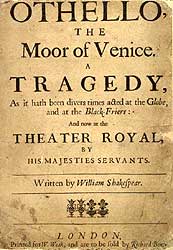
A 17th Century player's quarto |
The overall plot remains intact – the Moor (Othello in Shakespeare; Otello for Boito/Verdi) is duped by a vengeful Iago into believing his wife Desdemona to be unfaithful and murders her. Yet a major makeover to convert the play into an opera was both justified and necessitated by the inherent differences between the two media.
Boito's primary challenge was to drastically compress a play rich in incident and character without losing its essence. On a practical level, words are far slower when sung than spoken, as the rapid pace of Shakespearean delivery routinely heard on the stage is suitable only for patter songs and otherwise sounds inappropriately comedic. Thus, Boito condensed (depending on the edition and formatting) approximately 3,500 lines of the play into about 800. His most radical revision was to eliminate the entire first act of the play in which Iago, passed over by Othello for a promotion, seeks to avenge himself by informing Brabentio that Othello has despoiled his daughter Desdemona; before the Venetian senate Othello justifies his love for Desdemona, whom he actually has wed; and the Duke sends Othello to Cyprus to lead a battle against the Turks. Although discarding the character of Brabentio altogether, Boito used the essence of Act I by conveying Iago's personality in a venomous "Credo" aria in which he boasts of his evil nature, and by working the marital relationship of Otello and Desdemonainto a love duet. Neither scene has any parallel in the play. Boito achieved further abridgement and kept the action moving forward by excising the philosophical ruminations, extended metaphors and explications of feelings in which Shakespeare's characters freely indulge, resisting the temptation to turn them into arias, for which they seemed a natural fit. He also combined monologues into ensemble pieces and sacrificed several famous speeches, including Iago's "I have lost my reputation" and "Who steals my purse steals trash" and Othello's "It is the cause."
In the view of most critics, Boito necessarily had to simplify the characters. Thus, while George Marek asserts that Boito made Otello represent the suffering of everyman, other authors found Otello's Shakespearean nature to lie deeper – Thomas Mann considered him obsessed by a death-wish, A. C. Bradley a victim of disillusionment, Coleridge a tragic trusting soul, and Schlegel a barbarian in conflict with military discipline and Venetian refinement. Harold Rosenthal notes that Boito's Desdemona displays none of her wit in the play and George Martin finds her more mature than Shakespeare's bewildered innocent. On the other hand, Sandra Corse contends that Boito invested Iago with a religious and moral motivation for his evil acts, while Shakespeare provided a purely utilitarian one (his bitter resentment over losing a promotion to Cassio).
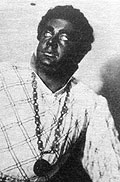
Melchior as Otello |
Yet, despite the time constraints, in addition to the "Credo" and love duet Boito added two choral interludes to calm the tension, a dramatic conclusion to Act III in which Otello collapses in a fit of rage, a prayer in which Desdemona sets a poignant mood that anticipates her murder and, most notably, a spectacular opening in which Otello arrives amid a fearful storm following his triumphant defeat of the Turkish fleet.
One of Boito's modest revisions of the play was to attenuate its racism (as well as its considerable erotically-charged language). Thus, Shakespeare's Iago alarms Brabentio that "an old black ram is tupping your white ewe," and others refer to Othello's "sooty bosom" and "thick lips" and call him a baboon, a "blacker devil" and a "lascivious Moor." Scholars point out that such terms emanated from characters who were inherently evil (Iago) or under extreme distress (Emilia [Desdemona's maid], upon discovering her murdered mistress), and thus were used to paint the speakers' characters rather than to reflect the author's own feelings. Yet, as Adrian Streete points out, even without racist taunts the opera remains infused with the invidious social ideology of a savage whose moral and cultural inferiority is assumed to be inherent in his racial origin. Indeed, in the view of 19th century Europe, how could miscegenation between a brutish Muslim African and a chaste Christian Venetian end other than in tragedy? Streete notes that the opening night poster depicted Otello entering Desdemona's bedchamber in traditional African garb, thus catering to fears of social pollution. (And let's note that for the next half-century, physical racial depiction persisted – tenors (all white) singing the lead role often used makeup to darken their complexion; perhaps the most extreme example is the Scandinavian Lauritz Melchior in deep blackface worthy of a minstrel show.) But even if purged of explicit racial contrast, traces remain in the underlying – and fully valid – thematic premise of Otello as an outsider to the society he is called upon to lead.
 Verdi prided himself as an Italian patriot, both politically and musically, and distanced himself from the resurgence of attention to German music, going so far as to state that it was a crime to imitate the harmonies, symphonic approach and leitmotifs that formed the basis of Wagner's structural method. Boito, on the other hand, urged a change in style away from the stale formulas into which he felt Italian opera had lapsed. Verdi took this as an insult and retaliated by mocking the constant modulations in Boito's Mefistofele.
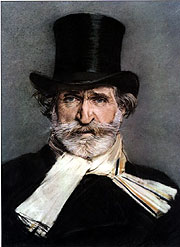
Portrait of Verdi by Giovanni Boldini |
In drawing distinctions between Verdi and Wagner, Paul Henry Lang cites not only their musical approaches, but the characters that their operas depict. Thus, Wagner's protagonists tend to be idealized mythological heroes whose fates come from external forces, whereas Verdi's are living characters subject to weak human passions. In that sense, Othello seemed an ideal vehicle for Verdi. Yet, it seems ironic that Verdi endured criticism that his Otello violated the esthetic principles of his own prior works and crossed the line into Wagner's rich harmonies, continuous writing, integration of arias into the whole, and strong reliance upon the role of the orchestra – the very qualities of German music that he decried.
Verdi deeply resented insinuations that he was influenced by Wagner. Even so, the unbroken flow of his music, its role as commentary upon the text, and the richness of his orchestration all tend to bridge the gap between the two primary schools of late-Romantic opera. Yet, in a clear break with Wagner Verdi used a thematic motif only once in Otello, and then to striking effect – the gorgeous tune that ends Act I to accompany Otello kissing Desdemona returns twice in the final act: to provide an ironic comment upon his murderous mission as he enters her chamber, and to underline the magnitude of his loss at the very end. Rather than rely on Wagnerian signposts, George Marek contends that Verdi assigns each major character individual musical expression – Desdemona's innocence is portrayed with lyric sweetness and fluid melody, Iago's inherent evil is implied through shakes and trills (within mostly deceptively light music), and Otello's evolution from the confident leader and lover in Act I to one who is tormented (Act II), becomes a tormentor (Act III) and finally is steeped in guilt and seeks atonement (Act IV) is complemented in each phase by appropriate musical delineation.
Ronald Kinloch Anderson distinguishes Otello from earlier Italian operas (including Verdi's)

Otello's love motif |
insofar as the former structure of self-contained numbers linked by passages of recital to carry the story forward is replaced with continuity in which aria-like passages arise out of the musical environment and are fully integrated into the whole. John Calder explains that while Otello is full of segments that correspond to traditional set numbers in Italian opera, their edges are smoothed and the pacing and balance between musical form and progress of the action is handled with unsurpassed dexterity. Thus an Act I "Brindisi" that emulates the traditional form of a drinking song breaks down as Rodrigo gets progressively more drunken and loses control and then, in lieu of the expected final cadence, plunges directly into the next bit of plot development. George Martin further notes that Otello's stock scenes all have a clear dramatic purpose and press forward to impart a natural pace to the overall arc of the drama. Thus Anderson notes that the Act I love scene consists of eight sequential sections, each with its own melody and key, and proceeds without the intrinsic repetition of traditional arias. (The elimination of set pieces would be completed in a final Shakespearean opera by Verdi and Boito that capped both their careers.

Iago's Credo – the sinister orchestral flourish, then mocking pious chant |
Connoisseurs consider their 1893 Falstaff to be the most sophisticated opera of all. Continuous, with colorful hints of melody, it sparkles with wit, wisdom and delicate expression, spiced by constant but subtle orchestral commentary.)
The music itself runs the gamut from the extreme intensity of vile hatred to the exquisite tenderness of immeasurable love – as Wechsberg notes, the music of Otello embraces all the emotions that make opera "grand" while all the time shaping and adding intricacy to the protagonists' characters through minute shades of meaning. Thus Iago's foul "Credo", in which he asserts his perverse values, opens with a sinister orchestral flourish, then proceeds to mock religion by emulating the monotone of chant, repeats itself to suggest an obsession, subsides into a hesitant whisper to curry intimacy, and then explodes into a wicked denial of faith to mock the audience for having let ourselves be drawn in to his confidence. Yet, there is subtlety in the musical characterizations – much of Iago's music is light and lyric, as deceptive in tone as his motives.
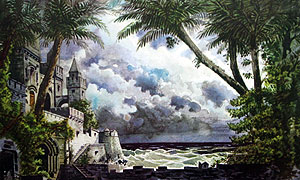
Zuccarelli stage design for Act I |
Corse finds symbolism in the musical settings – by the close of Act II Otello's vocals emulate Iago's, thus suggesting the extent to which the villain has infected his mind, and Desdemona tends to sing above the others, suggesting her isolation and freedom from the pervasive corruption. Harold Schonberg salutes Verdi's mastery as transcending mere accompaniment of singers to suggest what they are feeling or thinking beyond (or, for Iago, despite) their actual words. Corse adds that Verdi's music creates a psychological medium to reveal motives that characters actually hide in their language.
Perhaps the most remarkable musical segment is the very first, arguably the most striking opening of any opera – no overture nor even a prelude, but rather a startling fortissimo outburst of a fearsome storm that threatens the arrival of Otello's fleet. Perhaps comparable only to Beethoven's thunderstorm in his "Pastoral" Symphony, Verdi's apocalyptic depiction heaves and thrashes, "as if the whole universe were cracking open" as "great choral expressions of terror wash over each other like sheets of driving rain" (Garry Wills).

The unison chorale |
Yet (as in Beethoven's tempest) much of it is tensely quiet to create an atmosphere of expectancy. William Weaver asserts that each instrumental detail signifies an aspect of the storm and each vocal interjection represents the psychological situation of a character; thus Iago instantly shows his malevolence by wishing the fleet ill while the loyal Cassio is thrilled at the prospect of deliverance. Godefroy analogizes the amassing of disparate elements to a cinematic flow of tightly-edited dramatic angles. On a more symbolic level, to Corse the variety of widely-separated individual vocal outbursts denotes the volatility of human passions and a brief unison chorale ("Dio, fulgor, della bufera!") signifies mankind's attempt to marshall its resources to control the forces of nature. Indeed, the entire storm can be seen as a metaphor for the emotional turbulence to come, a feeling reinforced by a deep sustained organ pedal of C-C#-D that adds an intangible yet disquieting sense of foreboding.
At the height of the storm, Otello makes his hyper-dramatic entrance that affords a fine opportunity to consider the brilliance of both text and music. He sings:
Esultate!
L'orgoglio musulmano sepolto è in mar;
nostra e del cielo è gloria!
Dopo l' armi lo vinse l'uragano. |
Rejoice!
The Moslem's pride is buried in the sea;
ours and heaven's is the glory!
After our arms the sea defeated him. |
Benedict Sarnaker considers this the most difficult entry in all of opera, as the tenor must run onto the stage without any preparation to impart his hugely potent lines.

Otello's entrance – Esultate! |
The music itself is compelling yet complex – the first phrase ("Esultate!") is proud and fearless, followed by a descending chromatic phrase in military rhythm to literally depict the drowning of the enemy war fleet. The apparent modesty of Otello's mention of shared glory and the role of the sea that arise from the text, as well as the sheer brevity of what could have been a lengthy boast of his heroic travails, is overridden by the high tessitura and sustained volume of his forceful proclamation. The overall effect is of nearly supernatural powers – indeed, soon after Otello exits the storm subsides and human activity resumes, as the chorus turns first to thanks and then celebration.
The terror of the opening is balanced by Otello's intimate duet with Desdemona that closes the act – in Wills' apt phrase, cosmic convulsion turns into cosmic harmony. Anderson notes that the entire sustained scene is neither aria nor recitative but a feat of superlative harmonic and melodic beauty that reflects the evolution of the characters' feelings from moment to moment. To John Calder, it crystallizes the beauty of the marital relationship, and thus contrasts with the mechanization of evil that is about to destroy it. (In an early draft, a hidden Iago was to witness the love scene and mutter his disgust, but ultimately that wisely was discarded as too obvious a delineation of contrasting characters.) The love duet was Boito's idea, and Marek notes a practical reason why Shakespeare's play had no comparably fervent scene – in Elizabethan theatre, female roles were played by boys, and thus impassioned proclamations of love would have seemed incredible, if not outright comical. (Yet, Romeo and Juliet apparently passed muster at the time.)
 Philosophically, Peter Conrad contends that opera depends on tension between the inherent specificity of words and the abstract imagery of music. Corse finds these seemingly incompatible functions as melded in a great libretto, which communicates the precise meanings of the text while relying upon musical devices to add metaphoric syntax, ambiguity and resonance, creating a psychological medium in which music expresses tone and reveals mood and emotion more effectively than words. She cites as examples in Act I the shift from the fear and danger of the storm to rejoicing and adulation, Otello's entrance that makes clear his exalted place in society and the love scene's eschewal of details of courtship (which would have required lengthy speeches) for its underlying emotions (expressed in a few moments of tender music). More generally, she hails Verdi's music as refusing to take sides or suggest a definite value among the swirl of conflicting views, instead matching the complexity and confusion of the story. Thus, Otello's transformation from ardent lover to revenge-bent fiend in Act II seems far too rapid to make sense purely dramatically (even in the play), yet the music provides an emotionally convincing, if intentionally somewhat ambiguous, transition. Indeed much of the rationality required by narrative text is subsumed by the power of suggestive music. Consider the final words of Othello and Otello. Shakespeare's lines provide a complete summation of the tragic situation:
I kiss'd thee, ere I kill'd thee, no way but this,
Killing myself, to die upon a kiss.
Boito's words, though, are fragmented, make little sense on their own and require the wash of evocative music to elucidate their full meaning and impact:
Pria d'ucciderti … sposa … ti baciai.
Or morendo … nell'ombra … in cui mi giacio …
Un bacio … un bacio ancora … ah! … un altro bacio … |
Ere I killed you … wife … I kissed you.
Now dying … in the shadow … where I lie …
A kiss … one kiss more … ah! ... another kiss … |
Paul Henry Lang suggests that while drama and opera are independent entities, they are part of the same species, and that Verdi's symbols function on a musical, rather than intellectual, basis. Jenkins cites as a particularly effective example Otello's cries of "Sangue! Sangue! Sangue!" ("Blood! Blood! Blood!") in Act III when convinced that Desdemona is false and persuaded that she and Cassio must die – an actor alone cannot "make these words the extreme screaming agony that Shakespeare wanted" but when sung fortissimo against a full orchestra, rising F-F#-G#, they unmistakably convey Otello at the breaking point of rage. Jenkins concludes that throughout the opera, the "story of white-hot passion finds its real release in Verdi's tempestuous music." At the other end of the emotional spectrum, Marek cites Verdi's replacement of Shakespeare's Act V soliloquy in which Othello is torn between love and the need to mete out punishment with a probing recitatif passage for growling yet ruminative double basses. Wechsberg asserts music's ability to add shades of meaning to even the most carefully crafted words, citing the demonic undertones that accompany Iago's otherwise ebullient drinking song.
Shakespeare is thought to have based his 1602 play on a 1566 Italian source by Giraldi Cinthio (although with considerable revisions of the plot). Boito and Verdi, too, had a precedent in Rossini's 1816 opera Otello, which, although rarely heard today, remained quite popular at the time (until supplanted by the Verdi version) and was notable for its rare tragic ending. 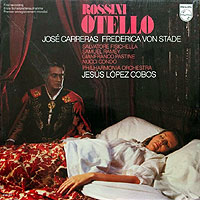 Written to order for Naples, which boasted a surfeit of fine tenors, the Rossini opera was essentially a love triangle and boasted florid roles for rivals Rodrigo and Otello and even the spurned Iago. Anthony Tommasini quipped that if the characters were called by any other names the audience would have had no idea they were watching a retelling of the famous play. He further chides that after the Verdi setting it's hard to accept a bel canto Otello who sings lilting tunes and dispatches phrase after phrase of coloratura roulades. Henry Simon notes that apparently Rossini had an optional conclusion in which Desdemona successfully pleads her innocence and joins in an ecstatic duet with Otello. (Verdi, too, was not entirely averse to sweetening – for an 1894 Paris production, he wrote a six-minute ballet (and quixotically specified the timing to be 5'59") to be inserted into Act III when the Venetian ambassador and his court arrive. Consisting of eight brief sections, it's quite tuneful and is occasionally performed as a separate light concert piece, although Verdi contended that "artistically speaking it is a monstrosity," as it interrupted the otherwise steady flow of the dramatic action.) Boito appropriated several features of Rossini's libretto (by Francesco di Salsa) that opened with Otello's arrival after defeating the Turkish fleet, added a prayer for Desdemona before her "Willow Song" and had her fall asleep before Otello enters to murder her. Heard today, the Rossini version is a highly effective example of its genre, but its ornate formalism is a world apart from the engrossing psychological realism of Verdi/Boito and underscores the brilliance of their achievement. Written to order for Naples, which boasted a surfeit of fine tenors, the Rossini opera was essentially a love triangle and boasted florid roles for rivals Rodrigo and Otello and even the spurned Iago. Anthony Tommasini quipped that if the characters were called by any other names the audience would have had no idea they were watching a retelling of the famous play. He further chides that after the Verdi setting it's hard to accept a bel canto Otello who sings lilting tunes and dispatches phrase after phrase of coloratura roulades. Henry Simon notes that apparently Rossini had an optional conclusion in which Desdemona successfully pleads her innocence and joins in an ecstatic duet with Otello. (Verdi, too, was not entirely averse to sweetening – for an 1894 Paris production, he wrote a six-minute ballet (and quixotically specified the timing to be 5'59") to be inserted into Act III when the Venetian ambassador and his court arrive. Consisting of eight brief sections, it's quite tuneful and is occasionally performed as a separate light concert piece, although Verdi contended that "artistically speaking it is a monstrosity," as it interrupted the otherwise steady flow of the dramatic action.) Boito appropriated several features of Rossini's libretto (by Francesco di Salsa) that opened with Otello's arrival after defeating the Turkish fleet, added a prayer for Desdemona before her "Willow Song" and had her fall asleep before Otello enters to murder her. Heard today, the Rossini version is a highly effective example of its genre, but its ornate formalism is a world apart from the engrossing psychological realism of Verdi/Boito and underscores the brilliance of their achievement.
In a sense Verdi's and Boito's adaptation may have respected Shakespeare in a way that superseded the stagecraft of their own time. G. B. Harrison suggests that Shakespeare had described his ideal presentation in Act III, scene 2 of Hamlet, where Hamlet instructs his players to: "Speak the speech … trippingly on the tongue … [not as] the town-crier [tearing] a passion to tatters" and to "o'erstep not the modesty of nature, for anything so o'erdone is from the purpose of playing … ." Yet his own troupe had little choice but to exaggerate declamation in their open-air theatre, whereas the enclosed intimacy of Verdi's opera house permitted far more subtlety in both words and music, and thus perhaps approached Shakespeare's own ideal more closely than Elizabethan presentations of the original play. The impact is even greater in recordings, in which purely audio information must conjure all the missing stage action, and which enable us to hear the most discreet subtleties of the orchestration.
 The Otello premiere on February 5, 1887 at La Scala was one of the most eagerly-awaited events of its time, both patriotically and culturally – after all, it had been 16 years since the prior opera of Italy's most famous composer, and even then Aida had opened far from home in Cairo. Rehearsals were tightly closed and Verdi insisted upon complete control over every aspect including the costuming, which was based on the early 16th century paintings of Carpaccio and Bellini – even the right to cancel if he was dissatisfied in any way. He needn't have worried – the success was mammoth. Blanche Roosevelt, an American in attendance, wrote that the audience of luminaries was seated an hour before the curtain, that the stage was bathed in unearthly radiance by newly-installed electric lights, and that there was so much jewelry that the house seemed spanned by a river of light. There were 20 curtain calls and numerous encores – even of the double bass interlude before Otello's entrance in Act IV. Otello was a huge popular success as well – crowds chanting "Viva Verdi!" triumphantly bore the composer back to his hotel and clamored outside his window until dawn.
Otello comprises four acts, each about a half-hour long. Here is an outline of the barest rudiments of the plot (and musical highlights):
- Act I – In a fearsome storm ("Una vela!"), the Venetian general Otello steps ashore and proclaims victory over the Turkish fleet ("Esultate!").
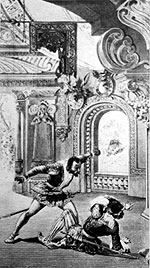
Otello demands proof of Iago's accustions
– contemporary print |
After a choral song around a bonfire ("Fuoco de gioia") Iago plots revenge for being passed over as captain in favor of Cassio, who gets drunk ("Brindisi"), starts a fight with Roderigo and is demoted by Otello. Left alone with Desdemona, Otello recalls their courtship ("Già nella notte") and she professes her love.
- Act II – Iago proclaims his philosophy of cynical cruelty ("Credo"), prods Cassio to appeal to Desdemona to restore his graces, fans Otello's jealousy, has his wife Emelia (Desdemona's maid) steal a prized handkerchief Otello had given Desdemona, tells Otello he found it in Cassio's room and claims he overheard Cassio pining for Desdemona in his sleep ("Era la notte"). Otello is deeply grieved ("Ora e per sempre addio") and then enraged as he enlists Iago for revenge in a stirring duet ("Si, pel ciel").
- Act III – Desdemona protests her innocence ("Dio ti giocondi") but is unable to produce her handkerchief, to Otello's dejection ("Dio mi potevi scagliar"). Otello overhears Cassio boasting of his love for his mistress Bianca but assumes he is speaking of Desdemona. When Cassio tells of finding the handkerchief in his room (where Iago hid it), Otello resolves to kill Cassio and strangle Desdemona in her bed. When the Venetian ambassador and his court arrive, Otello publicly abuses Desdemona, who laments her lost love ("A terra!"). As the distant crowd proclaims his glory, a distraught Otello faints from an epileptic attack and Iago gloats in triumph.
- Act IV – Desdemona prepares for bed, has a premonition of death, recalls a childhood song ("Salse, salse" – the "Willow Song"), prays ("Ave Maria") and falls asleep. Otello enters, kisses her tenderly, wakes her, accuses her of falsity, rejects her steadfast denials and strangles her. Others arrive and reveal Iago's treachery. Otello mourns Desdemona and his past glory ("Niun mi tema") and then stabs himself, kisses her one last time, and dies.
 Verdi worked closely with the original cast and personally coached them from the piano. Remarkably, we have recordings by the creators of two of the principal roles that are of key importance as documentation of Verdi's intentions. Even so, Gary Wills cautions that the artists' discs were made many years after the premieres and that in the interim their voices deteriorated, their styles changed and they added personal touches, and thus these later records can only approximate original impact. To that must be added the intimidating alien atmosphere of primitive recording conditions (congested venues, bare accompaniment, no reverberation or audience) and the inability of the acoustic process to capture the full range of dynamics and overtones, all of which often conspired to yield disappointingly stiff and tentative results. Indeed, the same challenges persisted to compromise most acoustic recordings of not only the creators' generation but the following one as well. Yet despite these concessions they all serve to deepen our understanding of Otello.
OTELLOs
IAGOs
Until January 1886, the new opera was to be called Iago, as both Boito and Verdi were enthralled with the complexity of that character. (Indeed, Godefroy notes that Boito had called his own opera Mefistofele rather than Faust.) Wechsberg attributes this to Verdi's Italian sense of drama, intrigue and passion, traits embodied in Iago rather than the more simplistic jealous Otello or the beatific Desdemona; as he puts it, on the stage demons are always more interesting than angels. Verdi considered Iago to exemplify Shakespeare's sweeping grasp of humanity, albeit its ugliest part.
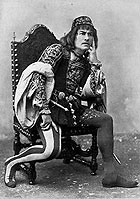
Victor Maurel as Iago |
At one point, Verdi described to a painter his conception of Iago as having an "absent-minded air, nonchalant, indifferent to everything, … speaking good and evil lightly as if he were thinking of something else," and someone who "could deceive anyone, even his own wife," rather than "a malicious fellow" who "puts everyone on his guard and deceives no one." He further envisioned Iago as a gentleman with fine pronunciation. In the finished opera, as in the play, Iago has more lines than any other character.
- Victor Maurel (1848-1923) – Maurel was a popular idol and lauded as a singing actor. He claimed that as early as 1881 Verdi promised to write the role of Iago for him and for years he hounded the composer. In 1885 Verdi traveled to Paris to hear Maurel and was suitably impressed. Although his voice was considered unremarkable and described as fragile and unreliable, Verdi didn't care – "As long as Maurel can speak I would rather he did Iago than anyone else." At the premiere Maurel reportedly garnered the most applause, while even Tamagno left the audience largely unmoved. In 1904 Maurel recorded Iago's deviously honeyed description of Cassio's dream ("Era la notte") in which he rouses Otello's suspicions. Maurel's dynamic range (which Verdi wanted throttled down to a barely audible ppppp) is uniform and his vocal inflections slight (but he modulates his timbre to observe the score's indication of sotto voce to mimic Cassio's nocturnal muttering), generally adheres to the specified note values and successfully projects a sense of insinuation as he softly caresses the words with a light vibrato while keeping the suppressed emotions well in check. In retrospect, it seems a shame that Maurel never recorded other stretches of Otello (especially the "Credo") that might have enabled him to display more of his fabled scope. More revealing of Maurel's range, and a measure of Verdi's esteem, is his spirited 1907 disc of "Quand'ero paggio" from Falstaff, Verdi's final opera, in which Maurel created the title role.
- Other Iagos – Other early Iagos document the change in vocal styles of the time. Mattia Battistini (1854-1928) is cherished as the foremost exemplar on records of the 19th century tradition of bel canto, which featured pure timbre, lyric expression and smooth, fluid, graceful delivery that strikes us as majestic yet somewhat abstract and lacking in characterization and drama. In keeping with his conception of the role, Verdi approved this approach to Iago, as he cast Battistini to tour with Otello (and even wanted him to create Falstaff in his final opera).
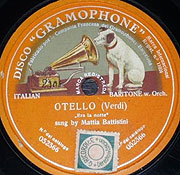 Battistini's 1914 "Era la notte" features magnificent tone, fully balanced registers and subtle control, even preserving a full sung quality in the sotto voce passages. (We can only wonder how he approached the less tender portions of the opera.) The incursion of the "modern" verismo style is documented in most other early recordings by Iagos. Thus a 1908 "Credo" by Mario Sammarco (1873-1930) is visceral, overtly emotive and somewhat crude, and his "Era la notte" is rough and makes little pretense of insinuation. A 1914 "Credo" by Titta Ruffo (1877-1953) displays cutting power, is constantly loud and overwhelming, and holds on to ringing climactic notes (although he does blanch his voice somewhat near the end). His 1920 "Era la notte" differentiates the sections and is somewhat attenuated, but still suggests a huge voice straining for release. Antonio Scotti (1866-1936) tempers his forceful 1906 "Credo" with yielding and modulated sections but constantly bends the musical line for emphasis. His 1907 "Bridisi" is so spirited that he blurs runs and misses several notes. A 1905 "Credo" by Eugenio Giraldoni (1871-1924) is aptly described by Scott as gruff, with huge vibrato and a monotonous mezzo-forte throughout, leaving the eloquence of bel canto far behind. Incidentally, only he and Scotti dispense with the concluding malevolent laugh that quickly became a performance tradition, even though it's in neither the score nor Verdi's detailed production book and can serve to defeat the purely musical implications with an unnecessarily explicit gesture. An interesting variant comes from Michael Bohnen (1887-1965), a bass with a sufficiently wide range to venture into baritone repertoire, whose 1916 "Credo" is exceptionally rich, although his German translation doesn't quite fit, with different syllables distended. In an effort to meet Verdi's ppppp specification toward the end, he slips beneath the noise floor of the acoustical apparatus. Battistini's 1914 "Era la notte" features magnificent tone, fully balanced registers and subtle control, even preserving a full sung quality in the sotto voce passages. (We can only wonder how he approached the less tender portions of the opera.) The incursion of the "modern" verismo style is documented in most other early recordings by Iagos. Thus a 1908 "Credo" by Mario Sammarco (1873-1930) is visceral, overtly emotive and somewhat crude, and his "Era la notte" is rough and makes little pretense of insinuation. A 1914 "Credo" by Titta Ruffo (1877-1953) displays cutting power, is constantly loud and overwhelming, and holds on to ringing climactic notes (although he does blanch his voice somewhat near the end). His 1920 "Era la notte" differentiates the sections and is somewhat attenuated, but still suggests a huge voice straining for release. Antonio Scotti (1866-1936) tempers his forceful 1906 "Credo" with yielding and modulated sections but constantly bends the musical line for emphasis. His 1907 "Bridisi" is so spirited that he blurs runs and misses several notes. A 1905 "Credo" by Eugenio Giraldoni (1871-1924) is aptly described by Scott as gruff, with huge vibrato and a monotonous mezzo-forte throughout, leaving the eloquence of bel canto far behind. Incidentally, only he and Scotti dispense with the concluding malevolent laugh that quickly became a performance tradition, even though it's in neither the score nor Verdi's detailed production book and can serve to defeat the purely musical implications with an unnecessarily explicit gesture. An interesting variant comes from Michael Bohnen (1887-1965), a bass with a sufficiently wide range to venture into baritone repertoire, whose 1916 "Credo" is exceptionally rich, although his German translation doesn't quite fit, with different syllables distended. In an effort to meet Verdi's ppppp specification toward the end, he slips beneath the noise floor of the acoustical apparatus.
DESDEMONAs
- Romilda Panteleoni (1847-1917) – Verdi conceived Desdemona as an ideal of goodness, resignation and sacrifice rather than a complex character – "the perfect Desdemona will always be the one who sings best."
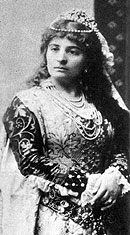
Romilda Pantaleoni as Desdemona |
He may have regretted casting Panteleoni (presumably at least in part because she was his conductor Faccio's lover), as he felt that she didn't understand the role and was too dramatic. Although Panteleoni was known for her wide range of roles and acting abilities, Blanche Roosevelt commented that at the premiere she rarely was in tune and had vile tone in her middle notes. Unfortunately, Panteleoni made no records and is barely mentioned in reference materials, so we have no basis on which to judge her creator's performance.
- Other Desdemonas – Perhaps the soprano who came closest to Verdi's proclaimed ideal was Nellie Melba (1861-1931), whose clear tone, minimal vibrato and completely accurate intonation produced exceptionally pure singing. Her 1910 records of the Act IV "Willow Song" and "Ave Maria" are things of abstract subtle beauty that make no pretense of inhabiting the character or creating any sense of drama. 1924 discs of the same pieces by Rosa Ponselle (1897-1991) are far more earthy and warm, trading polish for full dynamics that draw us into the range of feeling that Desdemona is struggling to suppress as she turns in for what she fears will be her final rest. A 1907 HMV disc of Desdemona's prostrate lamentation ("A terra," sung in German) finds Elsa Bland (1880-1935) in rich but rather wobbly voice, not inappropriate to her sorrowful feelings. Lina Pasini-Vitale (1872-1959), who later developed into a Wagnerian soprano, is well matched with Giovanni Zenatello to provide a convincingly ardent but mature pair of lovers in a 1910 waxing of the Act I duet. The straight-forward youthful simplicity of Miriam Licette (1892-1969), cast in the Melba mold, gains even greater impact in a 1924 duet (in English) alongside the crude bellowing of Frank Mullings's Otello.
 Despite their value, isolated solo numbers cannot convey the full measure of an opera conceived as an integral, continuous whole. In this survey, I've tried to focus on complete recordings that strike me as having particular historical or stylistic significance. The head notes list the singers of Otello, Iago and Desdemona, the orchestra and chorus, the conductor; timing in minutes; date (original label and, if different, the format I've heard).
- Giovanni Zenatello, Giuseppi Noto, [Lotte Lehmann], Royal Opera House Covent Garden Orchestra and Chorus, Vincenzo Bellazza; June 17, 1926 (live) (HMV 78s, Pearl CD)
Although far from complete, this was a momentous advance. Made barely a year after the launch of electrical recording, seven fragmentary sides were taken down by HMV in the course of a Covent Garden performance. 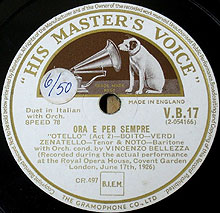 Part of the problem was the need to avoid anything of Desdemona, sung by Lotte Lehmann who was under contract to a competing label – a shame, as her contemporaneous studio recording of the "Willow Song" throbs with subtle shading of barely repressed emotion, fully consistent with her reputation (as described by Scott) for melding beauty and taste with spontaneity and intensity. Zenatello remains hugely expressive, and his voice, somewhat frayed toward the end of his career, adds a dose of pathos to his role – his "Niun me tema" is deeply moving (and at points barely audible) and (appropriate to the plot) he's aurally dominated in "Si pel ciel" by the barely known Giuseppe Noto as Iago. Three of the excerpts are unusual – "Oro mi signore" in which Iago sows the first seeds of doubt even while disingenuously warning Otello of the dangers of jealousy, Otello's Act III lament "Dio, mi patevi", and the arrival of the Venetian ambassadors, which provides a brief glimpse of the chorus. (Also included are the Brindisi and "Oro e per sempre.") The orchestral support is crisp and taut; the dynamics are far wider than the prior technology allowed, and Bellazza's conducting is thrilling – "Si pel ciel" grinds to a near-halt to stress its severe weight and then wildly accelerates to suggest the conspirators' insane obsession spinning out of control. Frustratingly, all sides end abruptly just as we're getting drawn in and two even cut off in mid-note. Yet the chunks afford a valuable hint of the extra jolt of a live performance, and a reminder that the opera's power had only barely been implied within the sterile confines of the acoustical studio. Part of the problem was the need to avoid anything of Desdemona, sung by Lotte Lehmann who was under contract to a competing label – a shame, as her contemporaneous studio recording of the "Willow Song" throbs with subtle shading of barely repressed emotion, fully consistent with her reputation (as described by Scott) for melding beauty and taste with spontaneity and intensity. Zenatello remains hugely expressive, and his voice, somewhat frayed toward the end of his career, adds a dose of pathos to his role – his "Niun me tema" is deeply moving (and at points barely audible) and (appropriate to the plot) he's aurally dominated in "Si pel ciel" by the barely known Giuseppe Noto as Iago. Three of the excerpts are unusual – "Oro mi signore" in which Iago sows the first seeds of doubt even while disingenuously warning Otello of the dangers of jealousy, Otello's Act III lament "Dio, mi patevi", and the arrival of the Venetian ambassadors, which provides a brief glimpse of the chorus. (Also included are the Brindisi and "Oro e per sempre.") The orchestral support is crisp and taut; the dynamics are far wider than the prior technology allowed, and Bellazza's conducting is thrilling – "Si pel ciel" grinds to a near-halt to stress its severe weight and then wildly accelerates to suggest the conspirators' insane obsession spinning out of control. Frustratingly, all sides end abruptly just as we're getting drawn in and two even cut off in mid-note. Yet the chunks afford a valuable hint of the extra jolt of a live performance, and a reminder that the opera's power had only barely been implied within the sterile confines of the acoustical studio.
- Nicola Fusati, Apollo Gianforte, Maria Carbone, La Scala Orchestra and Chorus, Carlo Sabajno; 121'; 1931-2 (HMV 78s; Preiser CDs)
This first complete Otello is exceptional. Unlike later casts of superstars pulled together from disparate sources (or dictated by licensing arrangements), here we have a team that functions within a living tradition. Although barely remembered today, the principals were eminent artists at La Scala (Fusati at the end of his career; Carbone at the start of hers) with compelling voices who sing with assurance, enthusiasm and characterization to inhabit their roles without allowing ego or emotion to overwhelm the musical flow. Thus notes are never held long enough to break a musical contour and Otello actually sings rather than yells "Sangue! Sangue! Sangue!" before launching his Act II vengeance duet with Iago and avoids hysterics at his demise. The chorus is spirited, and the leads blend gratifyingly within the ensembles yet are suitably differentiated to maintain individual musical lines. Sabajno, the experienced Italian house conductor for the Gramophone Company, leads the fastest account on records, propulsive yet never rushed, adding a sense of urgency to move Iago's mechanizations inexorably forward, and slowing only occasionally so the major dramatic peaks truly stand out. Although recorded on 32 78-rpm sides over a course of three months, the continuity is seamless. The only problems are thin (but clear) sound and balances that push the orchestra into the background, both as accompaniment and to diminish its impact in the few spots where it needs to dominate (opening the "Credo," closing Acts II and III). Sonics aside, the exceptional musicality of this outing endows it with lasting value that can be enjoyed time after time without the fatigue that can defeat enjoyment of repeated hearings of more individualized approaches.
- Giovanni Martinelli, Lawrence Tibbett, Elizabeth Rethberg/Maria Caniglia/Stella Roman, Metropolitan Opera Orchestra and Chorus, Ettore Panizza; 142'; 1938/1940/1941 (various LPs and CDs)
At the opposite extreme of the emotional spectrum are four performances with substantially the same cast (except the Desdemonas) recorded live at the New York Metropolitan Opera on February 12, 1938, December 3, 1938, February 24, 1940 and January 18, 1941. (These remarks are based on the second with Caniglia.) 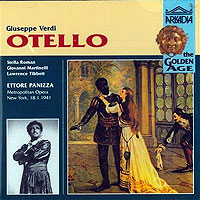 If the La Scala set was an animated yet respectful presentation of the unadorned score, these are unabashed interpretations. The sound is mediocre – barely AM quality, further compromised by dropouts and heavy compression, with loudness inferred more by the degree of distortion than actual volume level. While that leaves a lot to the imagination, it's not entirely bad, as it forces listeners to provide some of the missing sonic information and thereby assume an active role as a participant in the process of aural reconstruction. On the other hand, the sheer visceral excitement of the proactive conducting sets out the emotions explicitly rather than inducing us to delve beneath a relatively placid surface to generate personal feelings. Yet, it's riveting, as Panizza tends to whip up melodrama, even if at the expense of musical continuity. Thus in the opening storm he begins as fast as Sabajno, slows to a crawl and then varies tempos from phrase to phrase, making more of a visceral impression than narrative continuity. While climaxes, fueled by thundering timpani, are rapid and truly hair-raising, the overall timing (over 20 minutes slower than Sabajno), reflects deliberation and emphatic underlining especially during the dialog portions. Martinelli was hailed as Caruso's successor and reigned at the Met for over three decades in dramatic roles (and is he ever dramatic – audibly strangling as he collapses in a fit at the end of Act III and culminating an insanely emotive Act IV by gurgling his final words). Although Martinelli's emotive power is impressive and his ardent delivery deeply felt, Scott finds his tone forced, monotonous and lacking in grace, color or nuance. Tibbett, as Iago, has no such problems and seems the true star, a character actor who varies his voice from a frigid "Credo" (garnering one of only two ovations of the evening) to an unctuous Cassio's dream in which he injects meaning into every syllable. (The second ovation followed a lovely, if somewhat matronly, "Ave Maria" in Caniglia's Met debut.) Despite its sonic flaws, this Otello (and other live Met recordings of that time) remain remarkably vital experiences and validate those who recalled (and often lamented the passing of) the Met's "golden age." If the La Scala set was an animated yet respectful presentation of the unadorned score, these are unabashed interpretations. The sound is mediocre – barely AM quality, further compromised by dropouts and heavy compression, with loudness inferred more by the degree of distortion than actual volume level. While that leaves a lot to the imagination, it's not entirely bad, as it forces listeners to provide some of the missing sonic information and thereby assume an active role as a participant in the process of aural reconstruction. On the other hand, the sheer visceral excitement of the proactive conducting sets out the emotions explicitly rather than inducing us to delve beneath a relatively placid surface to generate personal feelings. Yet, it's riveting, as Panizza tends to whip up melodrama, even if at the expense of musical continuity. Thus in the opening storm he begins as fast as Sabajno, slows to a crawl and then varies tempos from phrase to phrase, making more of a visceral impression than narrative continuity. While climaxes, fueled by thundering timpani, are rapid and truly hair-raising, the overall timing (over 20 minutes slower than Sabajno), reflects deliberation and emphatic underlining especially during the dialog portions. Martinelli was hailed as Caruso's successor and reigned at the Met for over three decades in dramatic roles (and is he ever dramatic – audibly strangling as he collapses in a fit at the end of Act III and culminating an insanely emotive Act IV by gurgling his final words). Although Martinelli's emotive power is impressive and his ardent delivery deeply felt, Scott finds his tone forced, monotonous and lacking in grace, color or nuance. Tibbett, as Iago, has no such problems and seems the true star, a character actor who varies his voice from a frigid "Credo" (garnering one of only two ovations of the evening) to an unctuous Cassio's dream in which he injects meaning into every syllable. (The second ovation followed a lovely, if somewhat matronly, "Ave Maria" in Caniglia's Met debut.) Despite its sonic flaws, this Otello (and other live Met recordings of that time) remain remarkably vital experiences and validate those who recalled (and often lamented the passing of) the Met's "golden age."
- Gino Sarri, Antonio Manca Serra, Anna La Polla, Rome Opera, Alberto Paoletti; 132'; 1951 (Urania LPs; Preiser CDs)
This set deserves mention chiefly so as to include all the monaural studio Otellos. With a cast of virtual unknowns, it's fundamentally competent, accurately played and smoothly sung, but lacks focus and character and only rarely flirts with excellence. There's little spirit in the "Brindisi", tenderness in the love duet, malevolence in the "Credo", fire in the confrontations or heartbreak in the tragic finale. The choral sections come across comparatively well, but perhaps only because, by their nature, they are less amenable to interpretive individualization (and, speaking of which, Iago ends Act III with an inane laugh, as if Verdi's hair-raising conclusion didn't suffice). While mostly dispensable, if nothing else this represents a solid provincial production, illustrates the difference between a dutiful rendition and a genuine performance and sets a useful baseline against which to assess others of greater import.
- Ramón Vinay, Guiseppe Valdengo, Herva Nelli, NBC Symphony Orchestra and Choruses, Arturo Toscanini; 125'; 1947 (RCA LPs)
Even beyond its abundant glories, this recording boasts unique authenticity – Toscanini, then 19, deferred his own burgeoning calling as a conductor to play second cello in the La Scala orchestra during the season when it gave the world premiere of Otello under the composer's scrupulous preparation. 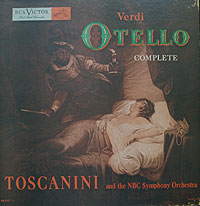 Sixty years later, Toscanini devoted two of his weekly NBC Symphony radio concerts to the opera. While his artistry clearly had evolved throughout his long career, the result exudes authority as a direct bearer of Verdi's own tradition and has been hailed by many as one of the all-time great opera recordings. Yet while calling this Toscanini's supreme achievement, Spike Hughes attributes its excellence less to Toscanini's personal association with the composer than to his lifetime reflection upon the letter and spirit of Verdi's music and his intense dedication to advocating it. (In a fascinating orchestral rehearsal of Act II, Toscanini begins with meticulous repetition of the opening phrase, but soon gets so carried away that he runs through the rest without pause, singing most of the lines himself.) Derived from the broadcasts in the notorious Studio 8-H plus a few rehearsal patches, the sound has fine presence, concentrated by the oft-criticized flat acoustics of that venue. Balances among orchestra, chorus and soloists are ideal, with each element in place, abetted, no doubt, by the concert format that avoided the inevitable sonic problems stemming from the spatial demands of staging. Tempos, too, all seem "right" – fully natural and never mannered, conveying the full import of the text without any need for exaggeration. The lead singers were relatively new to their roles and free of preconceptions, so Toscanini could mold them to be poised between song and declamation; as a result, they radiate ample characterization within the musical line. The sheer precision and focus generates energy of its own that compels attention. Overall, Toscanini adheres to the score with sufficient flexibility to avoid any sense of stiffness or rote, moving inexorably forward but just slow enough to reveal all the salient details. He convincingly makes the case for Verdi's unadorned genius and sets the standard against which all others have been measured. (Two confessions. First, this LP set was my earliest exposure to Otello and thus predictably formed the basis for my own comparisons. Second, for many years I was upset that the engineers had not removed a loud annoying rumble that afflicted the entire storm sequence, only later realizing that it wasn't a technical glitch at all, but rather Verdi's organ pedal point that Toscanini, typically, insisted be included, although to untutored ears it sounded like an unintended artifact of the recording.) Sixty years later, Toscanini devoted two of his weekly NBC Symphony radio concerts to the opera. While his artistry clearly had evolved throughout his long career, the result exudes authority as a direct bearer of Verdi's own tradition and has been hailed by many as one of the all-time great opera recordings. Yet while calling this Toscanini's supreme achievement, Spike Hughes attributes its excellence less to Toscanini's personal association with the composer than to his lifetime reflection upon the letter and spirit of Verdi's music and his intense dedication to advocating it. (In a fascinating orchestral rehearsal of Act II, Toscanini begins with meticulous repetition of the opening phrase, but soon gets so carried away that he runs through the rest without pause, singing most of the lines himself.) Derived from the broadcasts in the notorious Studio 8-H plus a few rehearsal patches, the sound has fine presence, concentrated by the oft-criticized flat acoustics of that venue. Balances among orchestra, chorus and soloists are ideal, with each element in place, abetted, no doubt, by the concert format that avoided the inevitable sonic problems stemming from the spatial demands of staging. Tempos, too, all seem "right" – fully natural and never mannered, conveying the full import of the text without any need for exaggeration. The lead singers were relatively new to their roles and free of preconceptions, so Toscanini could mold them to be poised between song and declamation; as a result, they radiate ample characterization within the musical line. The sheer precision and focus generates energy of its own that compels attention. Overall, Toscanini adheres to the score with sufficient flexibility to avoid any sense of stiffness or rote, moving inexorably forward but just slow enough to reveal all the salient details. He convincingly makes the case for Verdi's unadorned genius and sets the standard against which all others have been measured. (Two confessions. First, this LP set was my earliest exposure to Otello and thus predictably formed the basis for my own comparisons. Second, for many years I was upset that the engineers had not removed a loud annoying rumble that afflicted the entire storm sequence, only later realizing that it wasn't a technical glitch at all, but rather Verdi's organ pedal point that Toscanini, typically, insisted be included, although to untutored ears it sounded like an unintended artifact of the recording.)
- Ramón Vinay, Paul Schöffler, Dragica Martinis, Vienna Philharmonic, Vienna State Opera Chorus, Wilhelm Furtwängler; 147'; 1951 (EMI CD)
Although I cherish and revere nearly all of Furtwängler's live recordings, I've never fully warmed to this one, taped at the 1951 Salzburg Festival but issued years later. John Ardoin suggests its underlying problem: the mellow sound of the Viennese forces is utterly alien to the essential spirit of this work – in contrast to Wagner, whose operas soared above the real world,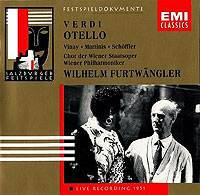 Verdi's characters are earthy and experience a full range of emotions, with a vivid sense of reality, cleanly executed musical lines and razor-sharp attacks. Ardoin further notes that Furtwängler approached the opera as a massive tone poem, with singers embedded within the instrumentation rather than being the focal points. This seems manifested in a number of ways. Furtwängler's climaxes tend to be attenuated and a smooth part of the overall flow that forms a vast arc of tragic development. His tempos are generally slow, straining the singers' endurance and intensity, casting instead a pall of overriding sadness and regret that pervades the entire plot, dimming even the festive bonfire chorus in Act I and turning the normally cheerful drinking song into a grim reflection on the futility of celebration (a fully apt transformation, given its function in the narrative scheme). The cumulative weight adds a crushing sense of impending tragedy to the normally upbeat Act II finale and inevitability and heartbreak to the measured final act, toward which all the rest has pointed. Of the soloists, only Vinay is immersed in Italian vocal tradition (largely repeating the drama of his work with Toscanini); the others are all German except his Desdemona (Dragica Martinis – a Croatian). Overall balances tend to favor the orchestra, imparting a symphonic aura that carries the thematic weight more than the narrative progress of the text. Fortunately, Furtwängler retained the original Italian, rather than using a clumsy and guttural German translation (as would purge much of the charm from his next Salzburg appearance in 1953 – Die Hochzeit des Figaro (a/k/a Le nozze di Figaro). Unfortunately, though, in the absence of original tapes the release had to be assembled by EMI from secondary sources that vary in quality, with the opening storm especially thin. Balances, too, are haphazard, with the "Esultate" barely audible. (Prior unauthorized LP editions were far worse.) Furtwängler's weighty personal conception serves as an absorbing contrast to the precise, idiomatic Toscanini approach. Verdi's characters are earthy and experience a full range of emotions, with a vivid sense of reality, cleanly executed musical lines and razor-sharp attacks. Ardoin further notes that Furtwängler approached the opera as a massive tone poem, with singers embedded within the instrumentation rather than being the focal points. This seems manifested in a number of ways. Furtwängler's climaxes tend to be attenuated and a smooth part of the overall flow that forms a vast arc of tragic development. His tempos are generally slow, straining the singers' endurance and intensity, casting instead a pall of overriding sadness and regret that pervades the entire plot, dimming even the festive bonfire chorus in Act I and turning the normally cheerful drinking song into a grim reflection on the futility of celebration (a fully apt transformation, given its function in the narrative scheme). The cumulative weight adds a crushing sense of impending tragedy to the normally upbeat Act II finale and inevitability and heartbreak to the measured final act, toward which all the rest has pointed. Of the soloists, only Vinay is immersed in Italian vocal tradition (largely repeating the drama of his work with Toscanini); the others are all German except his Desdemona (Dragica Martinis – a Croatian). Overall balances tend to favor the orchestra, imparting a symphonic aura that carries the thematic weight more than the narrative progress of the text. Fortunately, Furtwängler retained the original Italian, rather than using a clumsy and guttural German translation (as would purge much of the charm from his next Salzburg appearance in 1953 – Die Hochzeit des Figaro (a/k/a Le nozze di Figaro). Unfortunately, though, in the absence of original tapes the release had to be assembled by EMI from secondary sources that vary in quality, with the opening storm especially thin. Balances, too, are haphazard, with the "Esultate" barely audible. (Prior unauthorized LP editions were far worse.) Furtwängler's weighty personal conception serves as an absorbing contrast to the precise, idiomatic Toscanini approach.
- Mario Del Monaco, Aldo Protti, Renata Tebaldi, Orchestra and Chorus of the Academy of St. Cecilia, Rome, Alberto Erede; 131'; 1954 (London LPs)
- Mario Del Monaco, Aldo Protti, Renata Tebaldi, Vienna Philharmonic Orchestra, Vienna State Opera Chorus, Herbert von Karajan; 138'; 1961 (London LPs)
Rather than being organized around ensembles or forceful conductors, the 1954 set launched a trend of Otellos structured around superstar vocal casts, and especially the tenor portraying Otello – a course that has continued ever since. Here the three principals recut their roles in stereo for the same label in 1961. 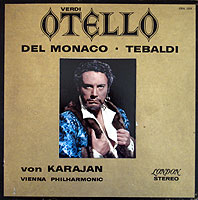 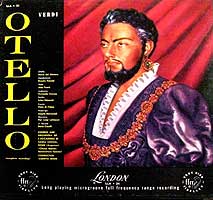 (Note that despite the apparent difference in timing the pacing is comparable, as Karajan includes the Act III ballet that, as Verdi feared, indeed interrupts the steady accumulation of tension.) Comparing the two, the earlier version has not only fresher voices but purer singing, as opposed to greater vocal histrionics in the remake. In addition, the earlier version features crisper sound and sharper attacks, perhaps a reflection of the Italian v. German outlooks of the respective conductors, orchestras and choruses. Del Monaco's commanding nasal squillo channels Tamagno. In the earlier version, in which the voices have greater prominence, he constantly dominates the texture, even in the love scene, which sounds far more insistent than tender in juxtaposition to the sheer beauty of Tebaldi's Desdemona. Much of this derives from the first venture having been mixed for release on monaural LPs (even though the current CD version is stereo). That, in turn, provides an opportunity to consider a benefit of stereo, which, especially in complex passages, can clarify textures across an aural soundstage without skewing the balances with spotlighting, obtrusive mixing and an overall synthetic quality that, when used indiscreetly, can defeat an impression of authenticity that opera recordings often seek to invoke. While anathema to early stereo pop records in which elements were artificially isolated with exaggerated separation, when applied sensibly to large ensembles, and especially operas, stereo can obviate the need for such technical measures. (Note that despite the apparent difference in timing the pacing is comparable, as Karajan includes the Act III ballet that, as Verdi feared, indeed interrupts the steady accumulation of tension.) Comparing the two, the earlier version has not only fresher voices but purer singing, as opposed to greater vocal histrionics in the remake. In addition, the earlier version features crisper sound and sharper attacks, perhaps a reflection of the Italian v. German outlooks of the respective conductors, orchestras and choruses. Del Monaco's commanding nasal squillo channels Tamagno. In the earlier version, in which the voices have greater prominence, he constantly dominates the texture, even in the love scene, which sounds far more insistent than tender in juxtaposition to the sheer beauty of Tebaldi's Desdemona. Much of this derives from the first venture having been mixed for release on monaural LPs (even though the current CD version is stereo). That, in turn, provides an opportunity to consider a benefit of stereo, which, especially in complex passages, can clarify textures across an aural soundstage without skewing the balances with spotlighting, obtrusive mixing and an overall synthetic quality that, when used indiscreetly, can defeat an impression of authenticity that opera recordings often seek to invoke. While anathema to early stereo pop records in which elements were artificially isolated with exaggerated separation, when applied sensibly to large ensembles, and especially operas, stereo can obviate the need for such technical measures.
- Jon Vickers, Tito Gobbi, Leonie Rysanek, Rome Opera Orchestra and Chorus, Tullio Serafin; 152'; 1960 (RCA Soria LPs)
When Serafin cut this, his penultimate recording, at age 82, he was the dean of Italian opera conductors, having begun his career in 1900 in the same manner as Toscanini, playing in the string section of the La Scala orchestra. 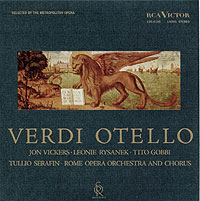 While occasionally disparaged as too restrained, his outlook understandably is autumnal (as, indeed, was the composer's at that stage in his life), and is ideally matched in the title role by the versatile Canadian Jon Vickers, whose eclectic career provides a fascinating alternative to the accepted tradition of specialized high-octane Italian belters. Vickers invests his role with magnificently smooth, sweet, sensitive singing, even muting the hysterics of his Act III epileptic fit and Act IV demise in favor of stylized song. In the process, he adds complexity and compassion to the character of Otello, projecting a susceptible human being beneath the bluster of a military hero and the fervor of a jealous lover. Indeed, the entire production gains in subtle psychological richness, abetted by the youthful eager innocence of Florindo Andresolli as Cassio, the detached but velvety texture of Leonie Rysanek as Desdemona and an Iago of Tito Gobbi whose malevolence arises out of the mundane (no "Credo" laugh – just a matter-of-fact statement) and thus seems all the more scary. As a result, the conflict grows more out of accumulating pain in a seething slow-motion nightmare than out of a chain of sudden emotional jolts. Even the ballet (omitted from the CD transfer) sounds drained of intrigue or joy but rather suggests a brief reprieve in an inescapable slide toward catastrophe. Originally released in RCA's deluxe Soria series with a lavishly-documented and -illustrated 48-page book, the rich, atmospheric recording further complements Serafin's and the cast's patient accretion of detail. While occasionally disparaged as too restrained, his outlook understandably is autumnal (as, indeed, was the composer's at that stage in his life), and is ideally matched in the title role by the versatile Canadian Jon Vickers, whose eclectic career provides a fascinating alternative to the accepted tradition of specialized high-octane Italian belters. Vickers invests his role with magnificently smooth, sweet, sensitive singing, even muting the hysterics of his Act III epileptic fit and Act IV demise in favor of stylized song. In the process, he adds complexity and compassion to the character of Otello, projecting a susceptible human being beneath the bluster of a military hero and the fervor of a jealous lover. Indeed, the entire production gains in subtle psychological richness, abetted by the youthful eager innocence of Florindo Andresolli as Cassio, the detached but velvety texture of Leonie Rysanek as Desdemona and an Iago of Tito Gobbi whose malevolence arises out of the mundane (no "Credo" laugh – just a matter-of-fact statement) and thus seems all the more scary. As a result, the conflict grows more out of accumulating pain in a seething slow-motion nightmare than out of a chain of sudden emotional jolts. Even the ballet (omitted from the CD transfer) sounds drained of intrigue or joy but rather suggests a brief reprieve in an inescapable slide toward catastrophe. Originally released in RCA's deluxe Soria series with a lavishly-documented and -illustrated 48-page book, the rich, atmospheric recording further complements Serafin's and the cast's patient accretion of detail.
- James McCracken, Dietrich Fischer-Dieskau, Gwyneth Jones, New Philharmonia Orchestra, Ambrosia Opera Chorus, John Barbirolli; 148'; 1967 (Angel LPs)
This recording reverts to the original Boito/Verdi conception, as Fischer-Dieskau's astoundingly nuanced rendition keeps the aural spotlight consistently focused on Iago. 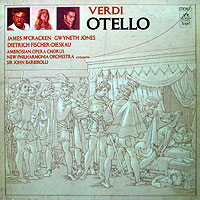 Stemming from his background as a famed lieder singer, he milks every word for meaning, especially rendering the softest passages with exquisite eloquence and sensitivity worthy of Schubert – he intones the chilling end of the "Credo" with supreme breath control, lubricates each syllable of "Era la notte," dampens his warning of jealousy with sickening sweetness and even injects uncommon lyrical flavor into his final "no" as he flees in Act IV. (The main dramatic problem with a focus on Iago, though, is that Act IV can seem anti-climactic, as Iago is barely present.) Fischer-Dieskau clearly dominates McCracken's Otello, which is comparatively bland, with a pale Act III breakdown and a bloodless "Si pel ciel" that devotes more attention to rolling "r"s than any infusion of passion. Even so, Otello's rare emotional outbursts, as when he accuses Desdemona of infidelity in "Dio! Mi potevi" and mourns her in "Niun me tema," tend to be exaggerated with near-comical zeal, a questionable marshalling of emotional reserves. But to give due credit, as he expires McCracken leaves off the final syllable of "un altro ba[cio]" altogether, a nice and subtly effective touch to depict his depleted vigor. Although in album notes Barbirolli traces his zeal to record Otello to vivid memories of his father and grandfather, both of whom played violin in the 1887 La Scala premiere, his leadership doesn't seem notably inspired. His slow tempos add exceptional poignancy to the more pensive pages, but elsewhere tend to dull the excitement, as does the hazy recording. Interestingly, though, he skirts tradition by casting Italians only in the minor roles – McCracken is American, Fischer-Dieskau German and Jones British (as are the orchestra, chorus and Barbirolli), a clear herald of the internationalization of opera amid the dissolution of the prior national schools. Stemming from his background as a famed lieder singer, he milks every word for meaning, especially rendering the softest passages with exquisite eloquence and sensitivity worthy of Schubert – he intones the chilling end of the "Credo" with supreme breath control, lubricates each syllable of "Era la notte," dampens his warning of jealousy with sickening sweetness and even injects uncommon lyrical flavor into his final "no" as he flees in Act IV. (The main dramatic problem with a focus on Iago, though, is that Act IV can seem anti-climactic, as Iago is barely present.) Fischer-Dieskau clearly dominates McCracken's Otello, which is comparatively bland, with a pale Act III breakdown and a bloodless "Si pel ciel" that devotes more attention to rolling "r"s than any infusion of passion. Even so, Otello's rare emotional outbursts, as when he accuses Desdemona of infidelity in "Dio! Mi potevi" and mourns her in "Niun me tema," tend to be exaggerated with near-comical zeal, a questionable marshalling of emotional reserves. But to give due credit, as he expires McCracken leaves off the final syllable of "un altro ba[cio]" altogether, a nice and subtly effective touch to depict his depleted vigor. Although in album notes Barbirolli traces his zeal to record Otello to vivid memories of his father and grandfather, both of whom played violin in the 1887 La Scala premiere, his leadership doesn't seem notably inspired. His slow tempos add exceptional poignancy to the more pensive pages, but elsewhere tend to dull the excitement, as does the hazy recording. Interestingly, though, he skirts tradition by casting Italians only in the minor roles – McCracken is American, Fischer-Dieskau German and Jones British (as are the orchestra, chorus and Barbirolli), a clear herald of the internationalization of opera amid the dissolution of the prior national schools.
- Placido Domingo, Sherrill Milnes, Renata Scotto, National Philharmonic Orchestra, Ambrosian Opera Chorus, James Levine; 134'; 1978 (RCA LPs)
- Luciano Pavarotti, Leo Nucci, Kiri Ti Kanawa, Chicago Symphony Orchestra and Chorus, Georg Solti; 130'; 1991 (Decca CDs)
To round out our selective (or, if I've missed your favorite Otello, arbitrary and useless) survey, it seems fitting to return the spotlight to the title character, and who better to do that than two of the self-proclaimed "Three Tenors." (The third, José Carreras, only recorded the role in the Rossini version.)
James Levine hailed the Toscanini Otello as "an outstanding candidate for the title of Greatest Opera Recording Ever Made," quite a compliment from one of the foremost opera conductors of our own time (and who led Otello more than any other opera at the Met). While preserving much of Toscanini's intensity, Levine's Otello boasts deeper inflection, giving orchestral details their full due while applying a superlative sense of drama to invest every phrase with consequence and meaning. 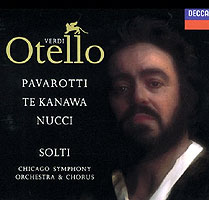 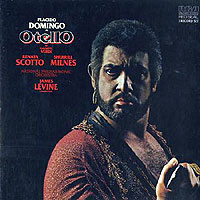 He also achieves more natural balances among his forces, perhaps reflecting the difference between the ambience of the opera house to which he was accustomed and the focused immediacy of Toscanini's broadcast studio. Milnes is an especially colorful Iago, tautly poised between bluster and obsequious charm and, abetted by Levine's bold showmanship, rendering an especially breathtaking "Credo." But the proper star of the show is Domingo. Bringing to bear his diverse and wide-ranging career of author, administrator, humanitarian, conductor, champion of new and obscure repertoire and a mammoth range of over 140 tenor roles, he impresses with a mature radiance allied with a complex mix of youthful exuberance, ominous undertones and barely suppressed obsession. His vocal acting is exceptionally credible, painting an affecting and convincing portrait of the tragic hero. Ideally paired with a ravishingly sweet and unfussy Renata Scotto, their love duet is one of the very few that convincingly conveys genuine affection and their blunt final act is engrossing in its impact. He also achieves more natural balances among his forces, perhaps reflecting the difference between the ambience of the opera house to which he was accustomed and the focused immediacy of Toscanini's broadcast studio. Milnes is an especially colorful Iago, tautly poised between bluster and obsequious charm and, abetted by Levine's bold showmanship, rendering an especially breathtaking "Credo." But the proper star of the show is Domingo. Bringing to bear his diverse and wide-ranging career of author, administrator, humanitarian, conductor, champion of new and obscure repertoire and a mammoth range of over 140 tenor roles, he impresses with a mature radiance allied with a complex mix of youthful exuberance, ominous undertones and barely suppressed obsession. His vocal acting is exceptionally credible, painting an affecting and convincing portrait of the tragic hero. Ideally paired with a ravishingly sweet and unfussy Renata Scotto, their love duet is one of the very few that convincingly conveys genuine affection and their blunt final act is engrossing in its impact.
Pieced together from a series of concerts that marked Solti's retirement as the long-time music director of the Chicago Symphony and Pavarotti's first attempt to tackle Otello (at age 56!), both conductor and superstar had something to prove. Despite a disappointingly lackluster opening storm (and "Esultate"), an unengaged love duet and a perfunctory Act III breakdown, the thrill of a great orchestra strutting at the top of its form and the sheer beauty of Pavarotti's voice ultimately become seductive. While lacking the characterization for which Verdi aimed, Pavarotti's vast reserves of power and pure sustained brilliance recall both stylistic poles of his artistic ancestors – the ringing "squillo" of Tamagno and the effortless technique of bel canto. This is hardly the "best" Otello nor "the only one you'll ever need to hear" but rather a compelling reminder that after all is said and done this is an opera that is designed to present stylized emotions and calls upon us to bridge the gap between art and emotional reality in a way that only personal immersion in music can do. In the process, it creates a more individualized and thus more meaningful truth than reality itself.
 While I'll take the credit (and blame) for my musical judgments, I have drawn upon the following sources for the information and references in this article, and recommend them for further reading (* denotes a principal source):
- BOOKS:
- Ardoin, John: The Furtwangler Record (Amadeus Press, 1994)
- * Chusid, Martin: "Verdi's Own Words" in The Verdi Companion (ed: William Weaver and Martin Chusid, Norton, 1979)
- Conrad, Peter: Romantic Opera and Literary Form (University of California, 1977)
- * Corse, Sandra: Opera and the Uses of Language – Mozart, Verdi and Britten (Associated University Presses, 1987)
- Dean, Winton: "Otello – The Background" in Calder, John: Otello (English National Opera Guide, 1981)
- * Godefroy, Vincent: The Dramatic Genius of Verdi – Studies of Selected Operas (St. Martin's Press, 1977)
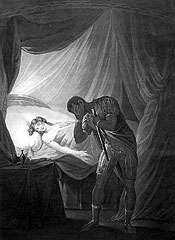
- Lang, Paul Henry: Music in Western Civilization (Norton, 1941)
- Martin, George: Verdi – His Music, Life and Times (Dodd, Mead & Co., 1963)
- * Osborne, Charles: Verdi – A Life in the Theatre (Knopf, 1987)
- * Phillips-Matz, Mary Jane: Verdi – A Biography (Oxford University, 1993)
- Sarnaker, Benedict: "Otello – Drama and Music" in Calder, John: Otello (English National Opera Guide, 1981)
- Schonberg, Harold: The Lives of the Great Composers (Norton, 1997)
- * Scott, Michael: The Record of Singing (Duckworth & Co., 1977)
- Shaw, Bernard: The Great Composers – Reviews and Bombardments, ed.: Louis Crompton (University of California, 1978)
- Streete, Adrian: "Shakespeare and Opera" in The Edinburgh Companion to Shakespeare and the Arts, ed. Mark Thornton Burnett (Edinburgh University Press)
- Tommasini, Anthony: "Opera Review: How Rossini Interpreted Shakespeare" (New York Times, July 9, 2001)
- * Wills, Gary: Verdi's Shakespeare – Man of the Theater (Viking, 2011)
- NOTES TO RECORDINGS:
- Anderson, Ronald Kinloch: "Verdi's Otello" (notes to Barbirolli/New Philharmonia LP box set, Angel SCL 3742)
- Barbirolli, Sir John: "Memories of Otello" (notes to Barbirolli/New Philharmonia LP box set, Angel SCL 3742)
- Freestone, John: [untitled] notes to "Francesco Tamagno – The Complete Recordings" (Pearl LP GEMM-208/9)
- Harrison, G. B.: [untitled] notes to "William Shakespeare: The Tragedy of Othello, the Moor of Venice" (The Shakespeare Recording Society, Caedmon SRS-225)
- Jenkins, Speight Jr.: [untitled] notes to "Martinelli, Jepson, Tibbett in Great Scenes from Verdi's Otello" (Victrola LP VIC-1385)
- * Marek, George P.: "Othello and Otello" (notes to Levine LP box set, RCA CRL3 2951)
- Rosenthal, Harold: "Verdi, Shakespeare and Boito" (notes to Barbirolli/New Philharmonia LP box set, Angel SCL 3742)
- * Sheehan, Vincent: "Verdi, Boito and Otello" (notes to Serafin LP box set, RCA Soria LDS-6155)
- * Simon, Henry W.: "Otello and Its Libretto" (notes to Toscanini/NBC LP box set, RCA LM-6107)
- Weaver, William: "Serafin Talks About Otello" (notes to Serafin LP box set, RCA Soria LDS-6155)
- * Wechsberg, Joseph: "Verdi and Otello" (notes to Karajan/Vienna LP box set, London OSA 1324)
- AND, OF COURSE:
- * Shakespeare, William: The Tragedy of Othello, the Moor of Venice (numerous publishers and editions)
- * Boito, Arrigo and Giuseppi Verdi: Otello, Dramma Lirico in Quattro Atti (vocal score, piano reduction by Michele Saladino; Ricordi, 1886)

Copyright 2014 by Peter Gutmann
|

